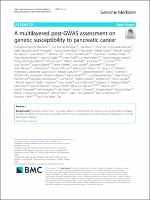| dc.contributor | Vall d'Hebron Barcelona Hospital Campus |
| dc.contributor.author | López de Maturana, Evangelina |
| dc.contributor.author | Rodríguez, Juan Antonio |
| dc.contributor.author | Alonso, Lola |
| dc.contributor.author | Lao, Oscar |
| dc.contributor.author | Molina-Montes, Esther |
| dc.contributor.author | Martín-Antoniano, Isabel Adoración |
| dc.contributor.author | Molero Richard, Francesc Xavier |
| dc.contributor.author | Balsells Valls, Joaquin |
| dc.date.accessioned | 2021-06-01T11:53:38Z |
| dc.date.available | 2021-06-01T11:53:38Z |
| dc.date.issued | 2021-02-01 |
| dc.identifier.citation | López de Maturana E, Rodríguez JA, Alonso L, Lao O, Molina-Montes E, Martín-Antoniano IA, et al. A multilayered post-GWAS assessment on genetic susceptibility to pancreatic cancer. Genome Med. 2021 Feb 1;13:15. |
| dc.identifier.issn | 1756-994X |
| dc.identifier.uri | https://hdl.handle.net/11351/6003 |
| dc.description | 3D genomic structure; Genetic susceptibility; Pancreatic cancer risk |
| dc.description.abstract | Background
Pancreatic cancer (PC) is a complex disease in which both non-genetic and genetic factors interplay. To date, 40 GWAS hits have been associated with PC risk in individuals of European descent, explaining 4.1% of the phenotypic variance.
Methods
We complemented a new conventional PC GWAS (1D) with genome spatial autocorrelation analysis (2D) permitting to prioritize low frequency variants not detected by GWAS. These were further expanded via Hi-C map (3D) interactions to gain additional insight into the inherited basis of PC. In silico functional analysis of public genomic information allowed prioritization of potentially relevant candidate variants.
Results
We identified several new variants located in genes for which there is experimental evidence of their implication in the biology and function of pancreatic acinar cells. Among them is a novel independent variant in NR5A2 (rs3790840) with a meta-analysis p value = 5.91E−06 in 1D approach and a Local Moran’s Index (LMI) = 7.76 in 2D approach. We also identified a multi-hit region in CASC8—a lncRNA associated with pancreatic carcinogenesis—with a lowest p value = 6.91E−05. Importantly, two new PC loci were identified both by 2D and 3D approaches: SIAH3 (LMI = 18.24), CTRB2/BCAR1 (LMI = 6.03), in addition to a chromatin interacting region in XBP1—a major regulator of the ER stress and unfolded protein responses in acinar cells—identified by 3D; all of them with a strong in silico functional support.
Conclusions
This multi-step strategy, combined with an in-depth in silico functional analysis, offers a comprehensive approach to advance the study of PC genetic susceptibility and could be applied to other diseases. |
| dc.language.iso | eng |
| dc.publisher | BMC |
| dc.relation.ispartofseries | Genome Medicine;13 |
| dc.rights | Attribution 4.0 International |
| dc.rights.uri | http://creativecommons.org/licenses/by/4.0/ |
| dc.source | Scientia |
| dc.subject | Pàncrees - Càncer |
| dc.subject | Malalties congènites |
| dc.subject.mesh | Pancreatic Neoplasms |
| dc.subject.mesh | Genetic Predisposition to Disease |
| dc.subject.mesh | Genome-Wide Association Study |
| dc.title | A multilayered post-GWAS assessment on genetic susceptibility to pancreatic cancer |
| dc.type | info:eu-repo/semantics/article |
| dc.identifier.doi | 10.1186/s13073-020-00816-4 |
| dc.subject.decs | neoplasias pancreáticas |
| dc.subject.decs | predisposición genética a la enfermedad |
| dc.subject.decs | estudio de asociación genómica completa |
| dc.relation.publishversion | https://doi.org/10.1186/s13073-020-00816-4 |
| dc.type.version | info:eu-repo/semantics/publishedVersion |
| dc.audience | Professionals |
| dc.contributor.organismes | Institut Català de la Salut |
| dc.contributor.authoraffiliation | [López de Maturana E, Alonso L, Molina-Montes E, Martín-Antoniano IA] Genetic and Molecular Epidemiology Group, Spanish National Cancer Research Center (CNIO), C/Melchor Fernandez Almagro 3, 28029 Madrid, Spain. CIBERONC, Madrid, Spain. [Rodríguez JA, Lao O] CNAG-CRG, Centre for Genomic Regulation (CRG), Barcelona Institute of Science and Technology (BIST), Barcelona, Spain. [Molero X, Balsells J] Vall d’Hebron Hospital Universitari, Barcelona, Spain. Vall d’Hebron Institut de Recerca (VHIR), Barcelona, Spain. Universitat Autònoma de Barcelona, Bellaterra, Spain. CIBEREHD, Barcelona, Spain |
| dc.identifier.pmid | 33517887 |
| dc.identifier.wos | 000616492900001 |
| dc.relation.projectid | info:eu-repo/grantAgreement/ES/1PN/2008-2011/PI11%2F01542 |
| dc.relation.projectid | info:eu-repo/grantAgreement/ES/PE2013-2016/PI12%2F01635 |
| dc.relation.projectid | info:eu-repo/grantAgreement/ES/PE2013-2016/PI15%2F01573 |
| dc.relation.projectid | info:eu-repo/grantAgreement/ES/PE2013-2016/PI18%2F01347 |
| dc.relation.projectid | info:eu-repo/grantAgreement/ES/2PN/2008-2011/RD12%2F0036%2F0034 |
| dc.relation.projectid | info:eu-repo/grantAgreement/ES/3PN/2008-2011/RD12%2F0036%2F0050 |
| dc.relation.projectid | info:eu-repo/grantAgreement/ES/4PN/2008-2011/RD12%2F0036%2F0073 |
| dc.relation.projectid | info:eu-repo/grantAgreement/ES/PE2013-2016/BFU2017-85926-P |
| dc.relation.projectid | info:eu-repo/grantAgreement/EC/FP7/259737 |
| dc.relation.projectid | info:eu-repo/grantAgreement/EC/FP7/256974 |
| dc.relation.projectid | info:eu-repo/grantAgreement/EC/FP7/609989 |
| dc.rights.accessrights | info:eu-repo/semantics/openAccess |

